What's Inside the Conrad Energy ‘9V’ PP3 Li-ion Battery?
In this article I take apart a Li-ion alternative to the classic PP3 9V battery, sold by Conrad Electronic (which actually proves to be Lithium-polymer). Is this just 2 cells shoved in a casing, or is there some extra circuitry? Is it a good source of LiPo cells?
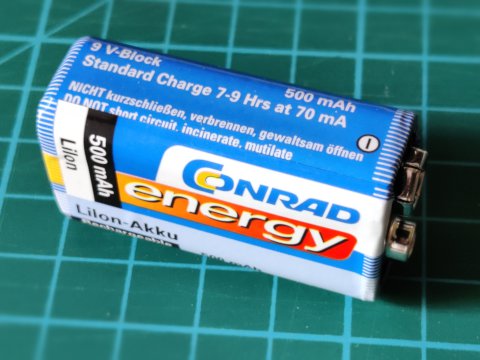
Intro
Obtaining cheap LiPo cells has become more of a hassle since there have been efforts to make shipping things from China less attractive. There are also stronger restrictions on shipping Li-ion or LiPo cells via airplanes, which may further complicate things. Sure, one could just order cells that are shipped by boat, but sometimes waiting a month just is not acceptable and as always with cheap Chinese things, you're never sure of the quality.
Apparently a good source of cells are disposable vape units, as demonstrated by Big Clive. Surprisingly these units—despite being single use—contain rechargeable cells, most likely because it is the most cost-effective way to get the required current rating in a small form factor. Unfortunately (or maybe fortunately), people seem to be more aware of their environment where I live, and I haven't found such things littered across the streets yet.
This is why I have started looking for a reliable local source of reasonably priced LiPo or Li-ion cells. I was especially looking for relatively compact cells with a decent capacity, around 500 mAh. An option would be to buy an RC battery pack, but those cells tend to be bulky due to their higher current rating which is overkill for what I need. I found out that there are ‘Li-ion’ variants of the classic PP3 9V block batteries.
The simpler variant relies on 2 cells in series with minimal extra circuitry, and it can only reach up to 8.4 V when fully charged and cuts out around 6 V. This makes it a bit wrong to call this variant “9V” and it is unsuitable for some applications that require higher voltages.
The other variant has a booster circuit to offer true 9 Volts across most of the discharge cycle. The downside is that this circuit may limit the maximum current draw, and it will cause a faster self-discharge.
The Conrad battery proves to be of the first variant. I ordered one to see how it is constructed and whether it is a practical source of compact high-quality cells.
Teardown
An obvious advance warning: in general it is a bad idea to rip apart things containing LiPo cells. The cells themselves are fragile pouches of chemicals, and puncturing or deforming them can lead to them heating up and possibly bursting into flames. Only do this if you know how to do it safely, and while having some emergency procedure in case things do go wrong (like Big Clive's fire containment pie dish).
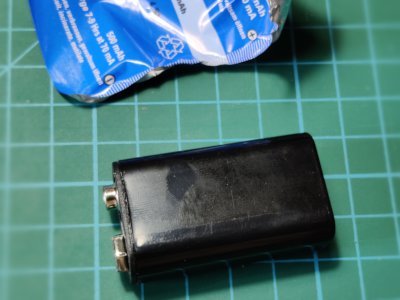
The first step is to blatantly ignore the warnings on the sticker. “Nicht gewaltsam öffnen” could be translated as: “do not open violently,” so we'll do it gently instead. Peeling off the sticker reveals that the battery is housed in the finest ABS plastique as AvE would call it. It is actually a little bucket with a lid containing the battery contacts. The glue that secures the lid can be defeated with some careful spudger work.
With the lid removed, our first question can be answered: yes, this battery does contain some circuitry, but more about that later. Sliding out the contents answers our second question: even though the battery is advertised as “Li-ion,” which I usually associate with a cylindrical form factor, it actually does contain 2 LiPo pouches. This makes sense because it allows to make better use of the rectangular shape of the battery than when trying to cram 2 cylindrical cells in it. (Of course LiPo is just a type of Li-ion, so this is only a matter of semantics.)
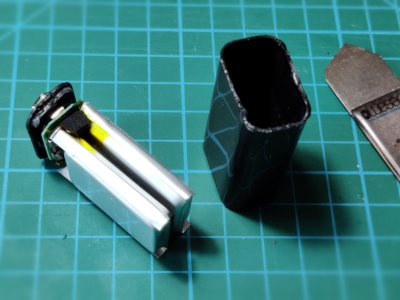
The cells are stuck together with some foam. A wee bit more capacity could probably have been crammed in there by using thinner foam and thicker cells, but there are probably constraints regarding cell dimensions, and also a safety margin in case the cells would fail and start to bloat.
The glue is pretty strong and again, merely trying to pull the cells apart is a bad idea due to the risk of deforming them. Typically one would use heat to soften the glue, but that would again be a bad idea in this case. Instead I used a slice of blister packaging to spudger the adhesive loose without exerting pulling forces on the cells.
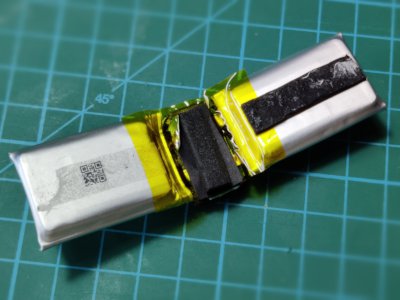
Coming right out of the packaging, both cells were at a voltage of 3.85 V with only a very minor difference. This is close to the optimal voltage for long-term storage. The cells are unmarked except for a QR code that seems to be a serial number. Their dimensions are 6.5×23×37mm, this would mean they are ‘652337’ cells according to LiPo cell nomenclature. This is actually a nice form factor for many projects. The cells appear to be of good quality, but only the future will tell whether this is true.
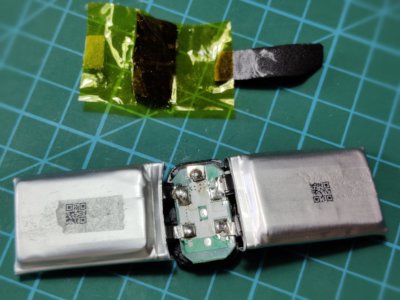
Using the bare cells like this is OK in projects that have LiPo-aware power management in the project's circuit itself. Otherwise, it is highly advised to add a protection circuit. I bought a bunch of tiny 15×3.5 mm ones on AliExpress a while ago which are a pretty good fit for these cells, I only need to cut a bit off the tabs to ensure there is no risk of bridging when soldering them onto the PCB. These protection boards prevent overcharging and deep discharging, and also disconnect the output in case a short-circuit is detected. They do not control charge current, a separate charge control PCB is needed for that. There are also boards with a USB socket and all these functions combined.
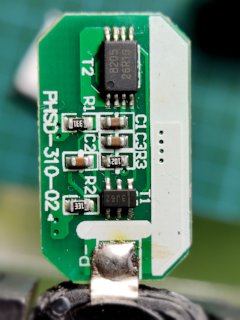
Further disassembly of the remainder of the battery reveals the construction of the PCB. It contains 2 ICs, one is marked 8205 and looks like a dual MOSFET, the other reads 3J62 and seems to be a protection circuit, but it is rather simplistic. By hooking up some power supplies, I could see that the output is disconnected whenever this IC sees either of the cells drop below 2.4 V, and it will re-engage when both cells are above approximately 3 V. Testing charging behaviour is a bit trickier but from what I can see, the charge current always goes through both cells in series, and the circuit will abort the charging whenever one of the cells goes well above 4.2 V. Both these observations imply that if a voltage difference develops between both cells, the usable capacity of the battery as a whole will decrease. This is a disadvantage of this design, which the other variant with a booster circuit and the cells in parallel does not have.
Conclusion
As a battery, this seems to be pretty decently constructed, but the simple circuitry will not protect against excessive charge currents, nor does it mitigate the problem of the two cells becoming unbalanced.
This ‘9V’ block battery proves to be a decent source of readily available LiPo cells. The advantages of doing this, are:
- These cells have a nice form factor, and together with their 500 mAh rating, this makes them suitable for many small projects.
- Quality is expected to be good. So far I have not been disappointed by Conrad Energy products, which are on par with brand name batteries.
- You don't need to wait a month for the product to arrive, or risk that it gets lost or intercepted by customs.
Disadvantages:
- The price is considerably higher than the usual Chinese fare.
- One needs to spend some time and care to liberate the cells from their housing without causing a catastrophic failure.
- Obviously one will void all warranty while butchering the original battery.